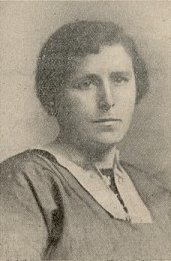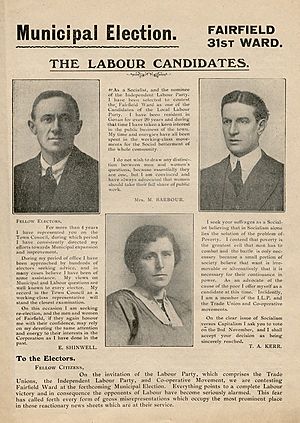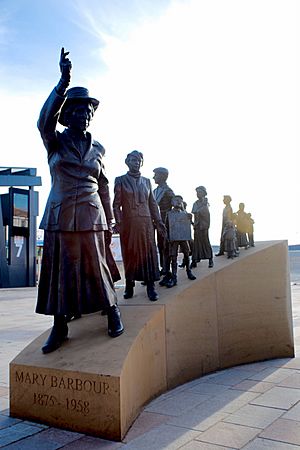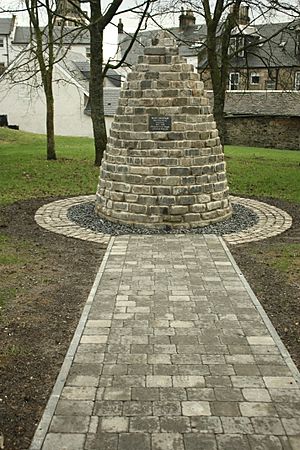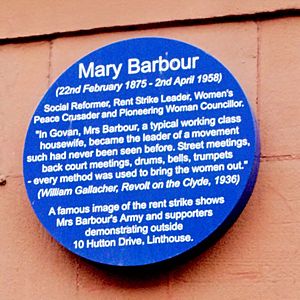Mary Barbour facts for kids
Quick facts for kids
Mary Barbour
|
|
|---|---|
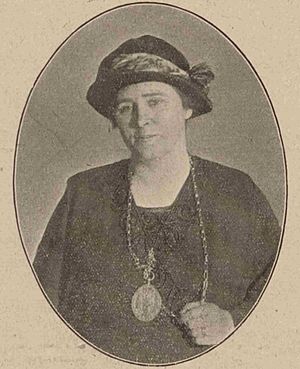 |
|
| Born |
Mary Rough
20 February 1875 Kilbarchan, Scotland
|
| Died | 2 April 1958 (aged 83) Southern General Hospital, Glasgow, Scotland
|
| Nationality | Scottish |
| Occupation | Political activist, local councillor, bailie, magistrate |
| Known for | Glasgow rent strikes, Women's Peace Crusade |
| Spouse(s) | David Barbour (m. 1896–1957) |
| Children | David (1897–1897) James William |
Mary Barbour (born Rough; 20 February 1875 – 2 April 1958) was a Scottish political activist. She became a local councillor, a bailie, and a magistrate. Mary Barbour was a key figure in the Red Clydeside movement in the early 1900s. She is especially remembered for leading the women of Govan during the rent strikes of 1915.
Contents
Mary Barbour's Early Life
Mary Barbour was born on 20 February 1875 in Kilbarchan, Scotland. She was one of seven children born to Jean and James Rough. Her father was a handloom carpet weaver.
Mary went to school until she was fourteen years old. In 1887, her family moved to Elderslie. Mary worked there as a thread twister and later as a carpet printer.
On 28 August 1896, Mary Rough married David Barbour, an engineer. By 1901, they had moved to Govan in Glasgow. They lived there with their son, James. Another son, David, had sadly died as a baby in 1897. By 1911, the family, including a third son, William, had moved to a new street in Govan.
In 1933, Mary Barbour moved to a council house in Glasgow. She lived there until she passed away at age 83. This was one year after her husband died. Her funeral was held at Craigton Crematorium, near Govan.
Mary Barbour's Activism for Change
Mary Barbour first became active in politics by joining the Kinning Park Co-operative Guild. Her most important political work began when she led the South Govan Women's Housing Association. This group was part of the Glasgow rent strikes in 1915.
Leading the Rent Strikes
During the rent strikes, Mary Barbour actively organized groups of tenants. She also helped people resist being evicted from their homes. The protesters became known as "Mrs Barbour's Army." Other important women in this group included Agnes Dollan and Helen Crawfurd.
Working for Peace: The Women's Peace Crusade
Mary Barbour helped start the Women's Peace Crusade (WPC). This happened at a big peace conference in June 1916. She worked with Helen Crawfurd and Agnes Dollan.
The WPC campaigned for a peaceful end to World War I. They held many outdoor meetings in Glasgow and Edinburgh. They wanted leaders to talk and find a solution.
The Russian Revolution and the Irish Easter Rising inspired more peace efforts in Scotland. In 1917, 70,000 people gathered for the annual May Day celebration in Glasgow Green. Women peace activists, including Mary Barbour, spoke at this event. This led to the re-launch of the Women's Peace Crusade in July 1917. About 10,000 people took part. The WPC continued its work until World War I ended.
Mary Barbour's Political Career
In 1920, Mary Barbour became a candidate for the Labour Party. She ran for the Fairfield ward in Govan. She was elected to the Glasgow Town Council. This made her one of the city's first women councillors.
Some people thought it was outrageous for a woman to run for office. But Mary Barbour believed women councillors were needed. She felt they could best deal with issues affecting women and children.
From 1924 to 1927, Mary Barbour served as one of Glasgow Corporation's first women bailies. A bailie is like a local official who helps with law and order. She was also appointed as one of the first women magistrates in Glasgow. In January 1928, she became a Justice of the Peace for the City of Glasgow.
Improving Health and Welfare
From 1925, Mary Barbour led the Glasgow Women's Welfare and Advisory Clinic. She worked with Dr. Nora Wattie, a specialist in child and female healthcare. Together, they set up this clinic. It was staffed by female nurses and doctors. The clinic later moved to a new location in Glasgow in 1932.
In November 1926, Mary Barbour attended the opening of the West Govan Child Welfare Clinic. This building is still used today as a health clinic.
As a councillor and bailie, Mary Barbour worked very hard. She helped the working class people in her area. She served on many committees that provided health and welfare services. Even after she retired in 1931, she continued to be involved in this important work.
Remembering Mary Barbour
Mary Barbour's work has been recognized in many ways.
Statue in Govan
In 2011, an artist created a picture of a possible statue for Mary Barbour. This sparked interest in building a real statue. In 2013, the Remember Mary Barbour Association (RMBA) was formed. They campaigned to raise money for a statue. Many groups supported them, including Glasgow City Council and the Scottish Parliament.
In 2015, five sculptors were chosen to create small models of their ideas. These models were shown to the public. Andrew Brown was chosen to sculpt the statue in February 2016.
The RMBA raised about £56,000 from public donations. This was about half the money needed. They planned events, like a concert, to raise the rest. The statue was finished in 2017 and officially revealed in March 2018.
The Kilbarchan Cairn
In May 2015, Renfrewshire Council agreed to pay for a special stone monument, called a cairn, in Mary Barbour's home village of Kilbarchan. The cairn cost about £6,000. It was placed on New Street, where Mary Barbour was born.
The cairn was revealed on 21 November 2015. Mary Barbour's family members were there. Renfrewshire Council also decided to create a Mary Barbour Prize. This prize is given every year to a student at Kilbarchan Primary School.
Clutha Bar Mural
Mary Barbour is one of two women shown in the Clutha Bar mural in Glasgow. Her image is based on a photograph of her in her Bailie's robes from around 1924. The Clutha Bar was the site of a helicopter crash in 2013. The mural honors the history of the area and shows many people who have visited there.
Blue Plaque in Linthouse
In November 2015, a blue plaque was placed at 10 Hutton Drive in Linthouse, Glasgow. This plaque remembers Mary Barbour and the actions of many women during the 1915 Glasgow Rent Strikes. The location is famous for a photo taken during a rent strike there.
The plaque describes Mary Barbour as a "Social Reformer, Rent Strike Leader, Women's Peace Crusader and Pioneering Woman Councillor." It also includes a quote from William Gallacher's book Revolt on the Clyde.


